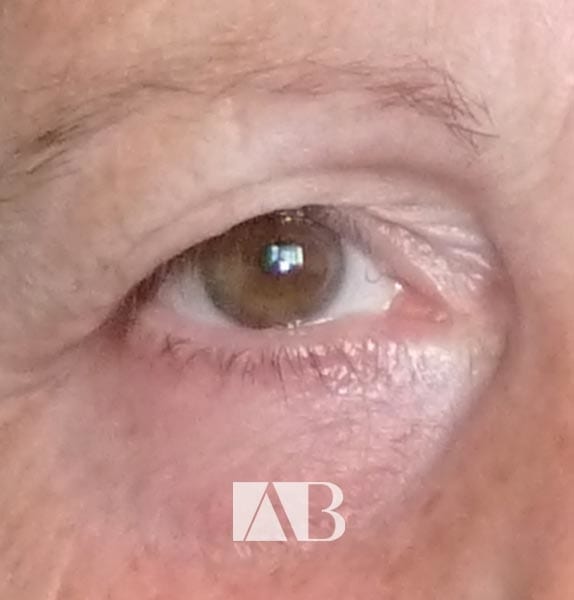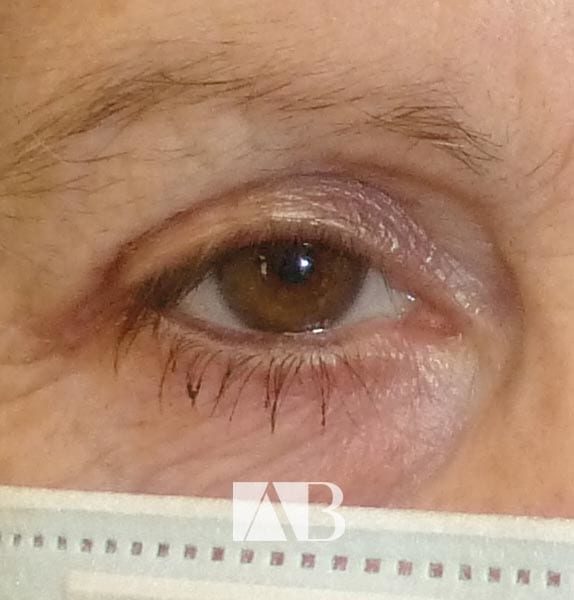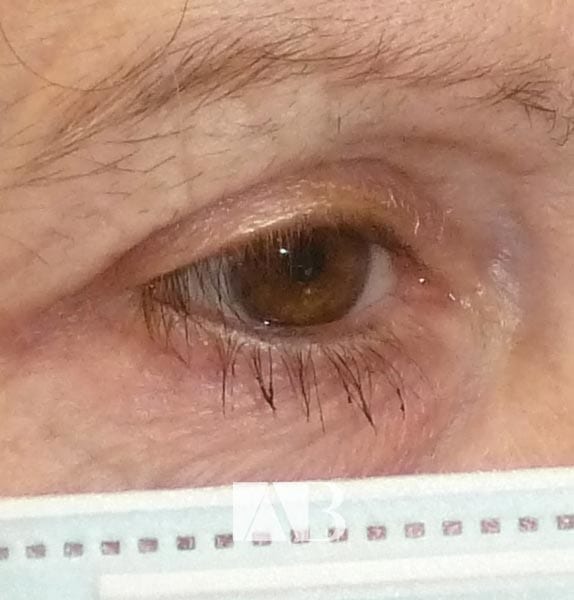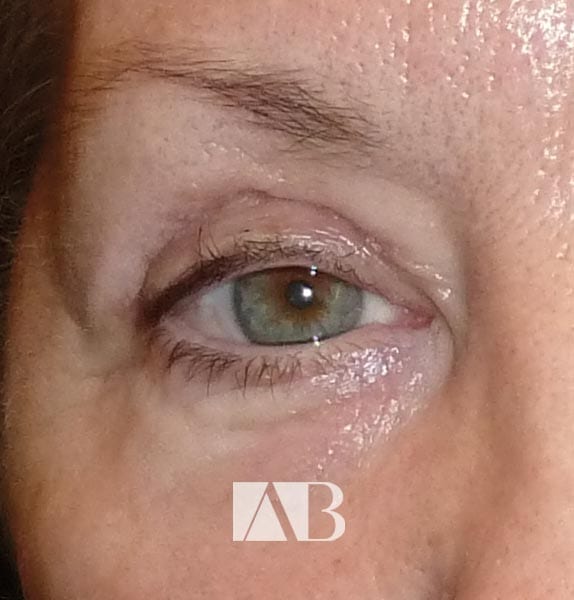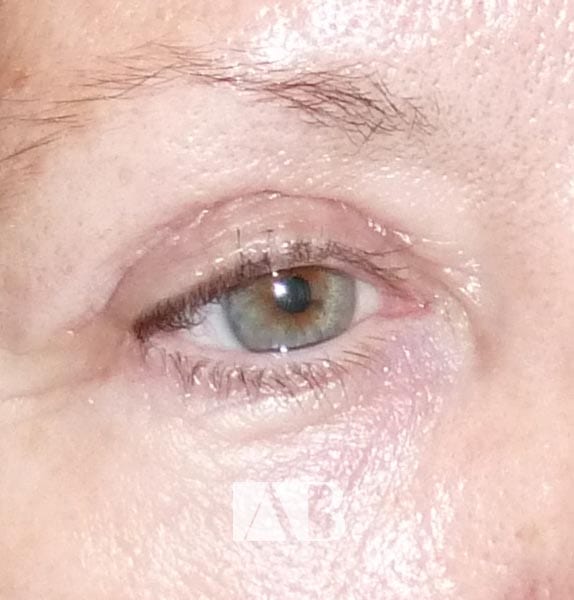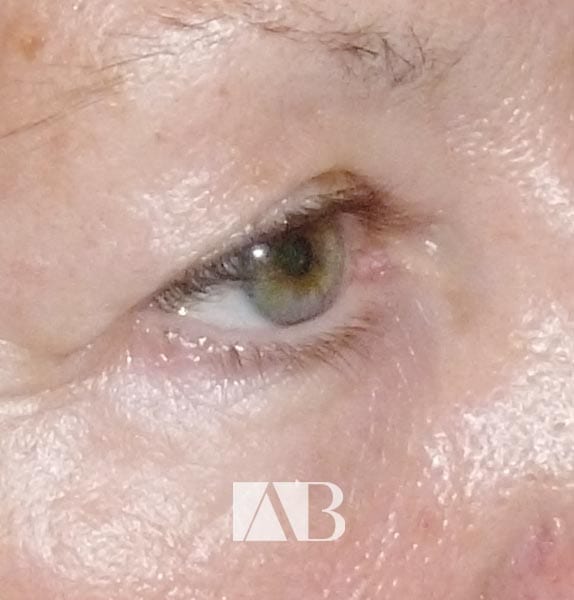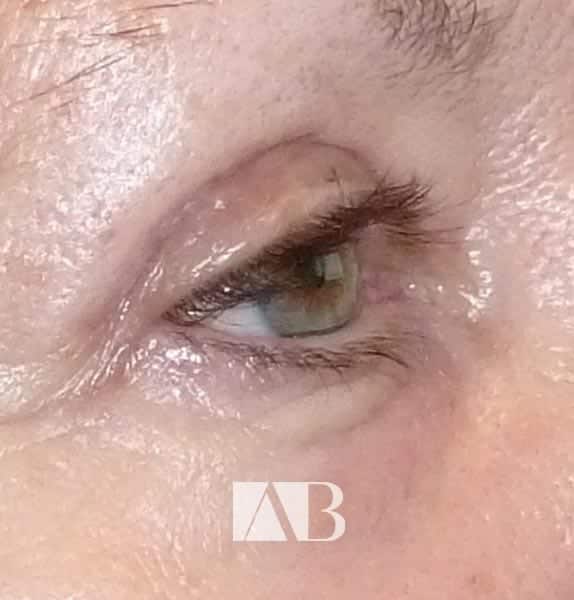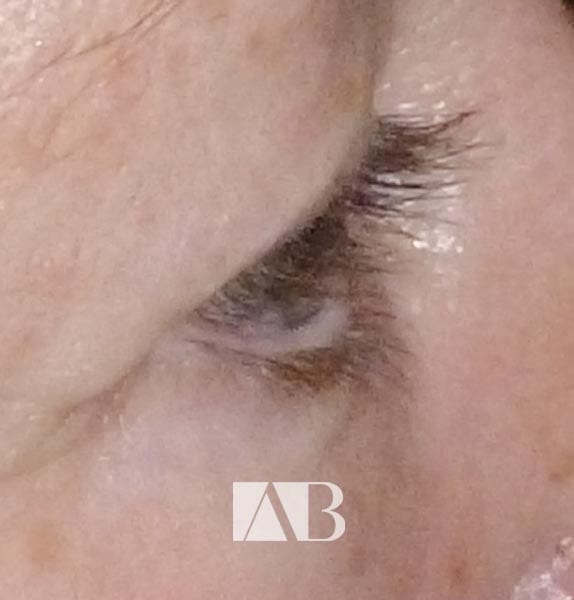Procedures
Upper Blepharoplasty
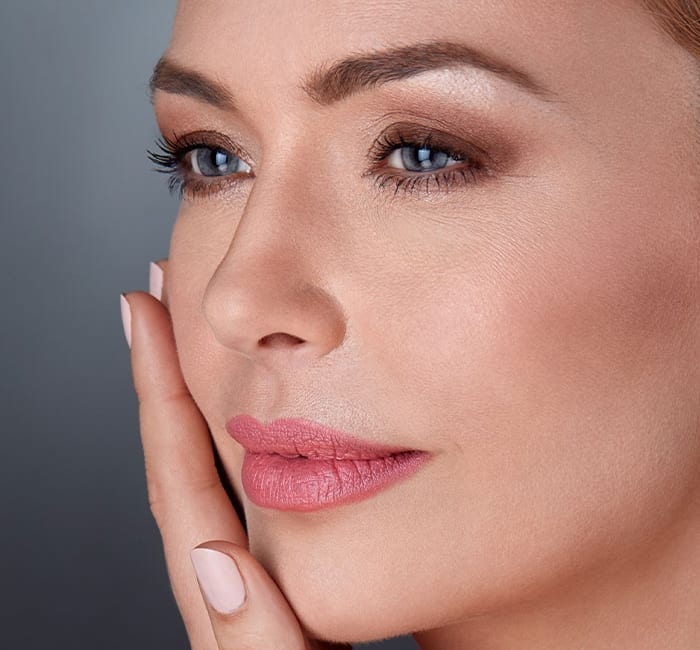
What is Upper Eyelids Surgery?
Upper eyelids surgery, also known as upper blepharoplasty, is a cosmetic procedure aimed at improving the appearance of the upper eyelids. This surgery can address different concerns, including removing excess skin that creates a droopy or tired appearance, eliminating fat that can cause puffiness in the eyelids, and creating a more youthful and refreshed look around the eyes.
Droopy eyelids are a common concern caused by natural skin ageing. As collagen and elastin decline, the delicate skin around the eyes becomes thinner and less able to bounce back. Weakened skin is then more likely to stretch, resulting in sagging and a droopy appearance.
An upper blepharoplasty is a surgical procedure that helps to reduce droopy eyelids and restore a more rested look to the face. This is a day case procedure that is performed using a local anaesthetic, and can address both of the eyes.
A cut is made along the natural crease of the upper eyelid to help make scarring less noticeable. From here Miss Breahna will trim away any excess skin before repositioning the skin and applying small stitches to close the incision. This procedure is often more effective than taking a non-surgical approach, and provides a longer-term solution to the appearance of ageing eyes. You may need to arrange for someone to take you home as the eye area will be tender, swollen and bruised, and the eyes will also be sensitive to light.
It may take up to 2 weeks for the side effects to subside, when the results of your procedure will become visible. Removing excess skin from above the eye will take away the tired look that droopy eyelids cause, and may have a positive effect on the overall facial profile. In some cases, upper blepharoplasty has also helped to improve a person’s quality of vision when overstretched skin has started to cover the eye. Upper blepharoplasty can be performed alongside other anti-ageing procedures to help restore a youthful look to the entire face.
At a glance
1-2 Hours
Local / General Anaesthetic
7-10 days off work
Table of Contents
Who Needs Upper Eyelids Surgery?
Upper eyelids surgery is suitable for individuals who have:
- Excess skin on the upper eyelids that causes folds, impairing vision or contributing to a tired or aged appearance.
- Puffiness in the upper eyelids due to fat deposits.
- A desire to improve the facial appearance for a more youthful or alert look.
Good candidates for this surgery are healthy, non-smokers with realistic expectations about the outcomes of the procedure. If you are considering this procedure, it’s important to consult with Anca to discuss your goals, potential risks, and whether this procedure is the right choice for your specific needs.
Benefits of Upper Eyelids Surgery
Upper eyelids surgery offers many benefits, including:
- Improved Vision: By removing excess skin that obstructs the field of vision, you can enjoy a clearer, unimpeded view.
- Aesthetic Enhancement: The removal of excess skin and fat can significantly rejuvenate the eye area, making the eyes appear more open, alert, and youthful.
- Increased Self-Confidence: Many patients report a boost in self-esteem and satisfaction with their appearance post-surgery.
- Minimal Scarring: The incisions made during upper blepharoplasty are placed in the natural crease of the eyelid, making any resulting scars well-concealed once healed.
- Long-Lasting Results: While the ageing process continues, the results of upper eyelids surgery can last for many years, providing a long-term improvement in appearance and vision.
These benefits highlight why upper eyelids surgery is a popular choice for those looking to address concerns related to ageing or the functionality of their eyelids.
Procedures
Before & After
See the difference Upper Blepharoplasty
has made for our clients
Types of Upper Eyelids Surgery
Traditional Upper Eyelid Blepharoplasty
This is the most common form of eyelid surgery, involving the removal of excess skin, muscle, and sometimes fat from the upper eyelids. The incision is made along the natural crease of the eyelid, allowing for the scar to be well-concealed once healed.
Ptosis Repair
Ptosis is a condition characterised by a drooping upper eyelid that can affect one or both eyes. Surgery to correct ptosis not only involves removing excess skin and fat but also tightening the muscle that lifts the eyelid.
Laser Upper Eyelid Surgery
In some cases, a laser is used instead of a scalpel to make incisions, which can offer the benefits of reduced bleeding and swelling. However, the choice between laser and traditional surgery depends on the surgeon’s expertise and the specific needs of the patient.
Upper Eyelids Surgery Explained
Upper eyelids surgery is performed as an outpatient procedure under local anaesthesia with sedation or general anaesthesia, depending on the complexity of the surgery and your comfort. The procedure usually takes about one to three hours. Here’s a general overview of the steps involved:
- Anaesthesia: The first step is administering anaesthesia to ensure your comfort during the procedure.
- Making the Incision: Anca makes an incision along the natural crease of the upper eyelid. Through this incision, excess skin, muscle, and possibly fat are removed or repositioned as needed.
- Adjustments: Depending on the individual case, Anca may perform additional adjustments, such as tightening the eyelid muscles to correct ptosis.
- Closing the Incisions: The incisions are then closed with sutures, which may be removed after a week or so, or absorbable sutures that do not require removal.
- Recovery: After the surgery, you are taken to a recovery area where you are monitored as the anaesthesia wears off. You can go home the same day, accompanied by a friend or family member.
Upper eyelids surgery can be customised to meet the specific needs and goals of each patient. The procedure varies depending on the extent of correction required, your anatomy and desired outcomes. The primary types of upper eyelid surgery are Traditional Upper Eyelid Blepharoplasty, Ptosis Repair, and Laser Upper Eyelid Surgery. Each type of surgery has its indications, benefits, and potential risks, which should be thoroughly discussed with Anca during the consultation process.
Recovery and Aftercare
The recovery period is an important phase where you must follow Anca’s instructions carefully to ensure optimal healing and outcomes. Here’s what to expect during the recovery process:
- Immediate Post-Op: You may experience swelling, bruising, irritation, or dry eyes, which can be managed with medication, cold compresses, and ointment. Vision might be blurry temporarily due to the ointment applied to the eyes.
- First Week: During the first week, you will need to rest and avoid any strenuous activities. The head should be kept elevated to reduce swelling. Sutures are typically removed or dissolve during this period.
- Following Weeks: Swelling and bruising will gradually diminish over the next few weeks. Most patients feel comfortable returning to work and social activities within 10 to 14 days, although this can vary.
- Long-term Care: It’s important to protect the eyes from the sun and avoid rubbing them. Full healing and the final results of the surgery may take several months to become apparent.
You should attend all follow-up appointments with Anca to monitor your recovery and address any concerns.
Reviews
Patient satisfaction is the top priority for Anca. You can find how patients feel about her work below.
I’m Absolutely Delighted with the Results from my Blepharoplasty
I decided to have a Blepharoplasty as I had tired looking eyes, excess skin and droopy eyelids. Anca Breahna was the consultant who performed my surgery, who I am so grateful for. From the initial consultation to the post surgery appointments, Anca was professional, attentive and caring. Anca is so calmly reassuring, I felt extremely safe in her hands, which made me worry less about the procedure. As any surgery can be somewhat nerve-racking, even if it’s elective. I could not be happier with the results, I have almost no scarring, and it’s only been three months since my surgery. Wearing eye makeup is a joy again. Thank you Anca and the team.

I decided to have a Blepharoplasty as I had tired looking eyes, excess skin and droopy eyelids. Anca Breahna was the consultant who performed my surgery, who I am so grateful for. From the initial consultation to the post surgery appointments, Anca was professional, attentive and caring. Anca is so calmly reassuring, I felt extremely safe in her hands, which made me worry less about the procedure. As any surgery can be somewhat nerve-racking, even if it’s elective. I could not be happier with the results, I have almost no scarring, and it’s only been a couple of months since my surgery. Wearing eye makeup is a joy again. Thank you Anca and the team.
Pricing & Funding for Upper Eyelid Surgery in the UK
The cost of upper eyelid surgery in the UK can vary widely depending on the surgeon’s experience, the complexity of the procedure, and the location of the surgery. On average, prices can range from £2,000 to £4,000. It’s important to note that these costs cover the surgeon’s fee, anaesthesia, the facility fee, and follow-up appointments.
Most cosmetic surgeries, including upper eyelid surgery, are not covered by the National Health Service (NHS) or private health insurance as they are considered elective procedures. However, if the surgery is deemed medically necessary to improve vision or for other health reasons, there may be an opportunity for funding or partial coverage under specific circumstances.
Prospective patients should thoroughly research and consult with multiple surgeons to understand the full scope of the costs involved. Additionally, it’s crucial to consider the qualifications and experience of the surgeon and the quality of care provided when making a decision, rather than basing the choice solely on price.
Further Reading
- Read Anca’s Blog on Beginners Guide to Eyelid Surgery
- Read Anca’s Blog on Recovery after Eyelid Surgery
- Read Anca’s Blog on What Can Be Done to Reduce Eyelid Surgery Scars?
- Read Anca’s Blog on Solutions for Saggy Eyelids
- Read Anca’s Blog on When Can I Exercise after Eyelid Surgery
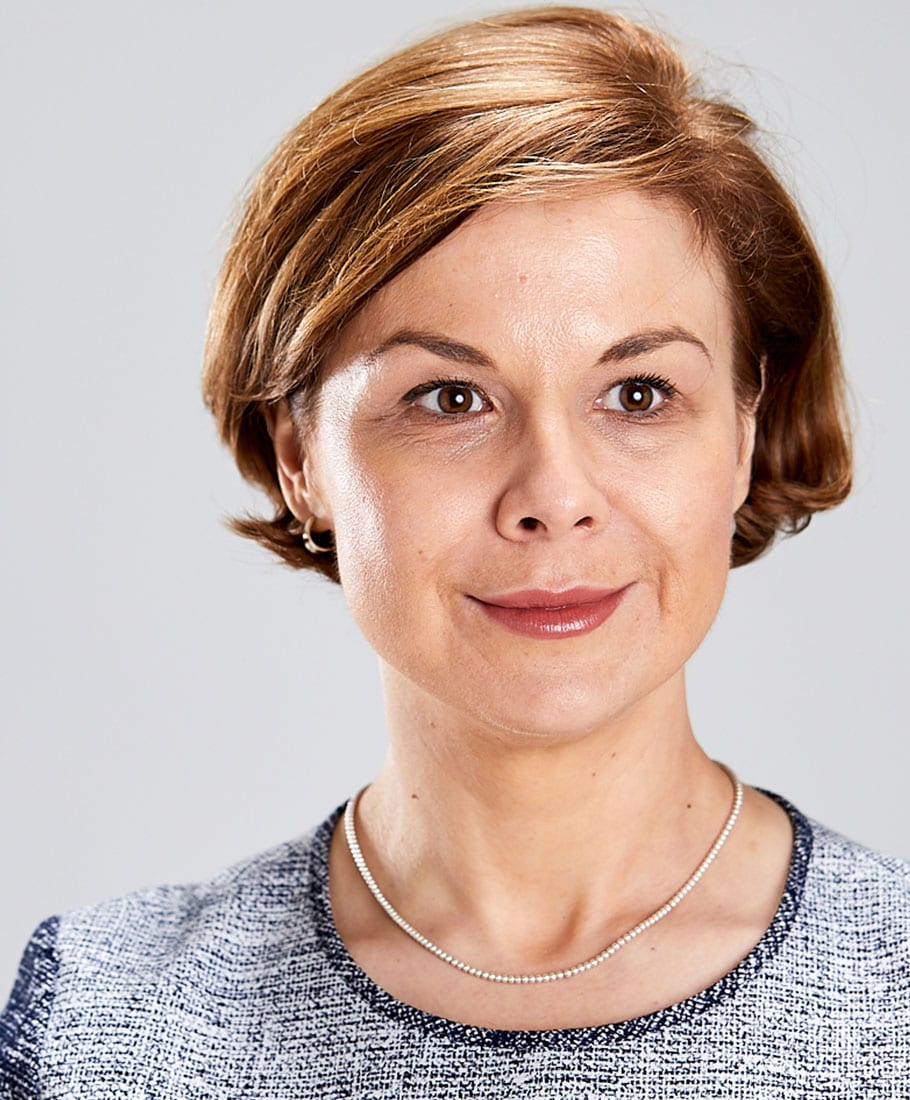
Procedure
Frequently asked questions
Am I suitable for upper blepharoplasty?
At Chester Cosmetic Surgery, Miss Breahna will establish your suitability for this procedure at a comprehensive consultation.
She often recommends this procedure when the skin on the upper eyelid has become stretched and is sagging lower than is considered the norm affecting your peripheral vision.
Does Upper Blepharoplasty hurt?
Upper blepharoplasty is performed using a local anaesthetic at Chester Cosmetic surgery. The injections are made with tiny needles, causing minimal discomfort and are generally well tolerated. Oral pain relief will be prescribed while the eyes are healing.
What can I expect after Blepharoplasty Surgery?
Immediately after the procedure the eyes will feel sore, and swelling and bruising will develop. Ice packs applied intermittently and sleeping propped up will help to reduce swelling. You may find it helps to wear sunglasses while the eyes feel sensitive.
When will I see the results?
It may take several weeks for swelling and bruising to totally disappear, which is when you will start to see the full effects of the procedure.
There will be a permanent scar but this will be hidden within the eye’s natural crease.
Scarring may look particularly red for up to 6 months when it will fade and blend in better with the surrounding skin.
What are the risks associated with upper eyelid surgery?
As with any surgery, there are risks, including infection, bleeding, scarring, asymmetry, and changes in vision. Discussing these risks with Anca during the consultation can help you make informed decisions.
Will there be visible scars?
Incisions are made along the natural crease of the eyelid, making scars well-concealed once they heal.
Are there alternatives to surgery?
Non-surgical treatments like neuromodulator injections or fillers can offer temporary improvements but cannot remove excess skin or significantly alter the eyelid’s appearance like surgery can.
What if I choose not to have the surgery?
If surgery is recommended for functional reasons and not performed, vision impairment and symptoms may persist or worsen. For cosmetic concerns, not having the surgery simply means continuing with the current appearance of the eyelids.
Is upper eyelid surgery painful?
Pain is typically minimal and manageable with medication. Most patients report more discomfort from swelling and bruising than pain.
Will the results last forever?
The results are long-lasting, but the ageing process continues. Lifestyle choices and genetics play a role in how long the benefits last.
How should I prepare for the procedure?
Preparation includes following Anca’s instructions, which may involve stopping certain medications, arranging for someone to drive you home, and preparing a recovery area in your home.
When will I see the results?
Initial swelling and bruising will obscure the results at first. Most patients see significant improvements within a few weeks, with final results apparent after several months.
Medical References about Upper Blepharoplasty
- Updates on upper eyelid blepharoplasty – PMC
- Upper Eyelid Blepharoplasty: Surgical Techniques and Results—Systematic Review and Meta-analysis
- Brow Position Change and its Potential Risk Factors Following Upper Blepharoplasty
- Changes in Tear Meniscus Analysis After Ptosis Procedure and Upper Blepharoplasty
- Contemporary Upper Blepharoplasty – Sage Journals
